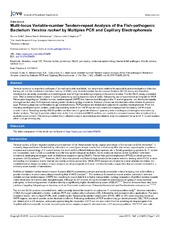Multi-locus variable-number tandem-repeat analysis of the fish-pathogenic bacterium Yersinia ruckeri by multiplex PCR and capillary electrophoresis
Peer reviewed, Journal article
Published version

Åpne
Permanent lenke
http://hdl.handle.net/1956/21265Utgivelsesdato
2019-06-17Metadata
Vis full innførselSamlinger
Sammendrag
Yersinia ruckeri is an important pathogen of farmed salmonids worldwide, but simple tools suitable for epizootiological investigations (infection tracing, etc.) of this bacterium have been lacking. A Multi-Locus Variable-number tandem-repeat Analysis (MLVA) assay was therefore developed as an easily accessible and unambiguous tool for high-resolution genotyping of recovered isolates. For the MLVA assay presented here, DNA is extracted from cultured Y. ruckeri samples by boiling bacterial cells in water, followed by use of supernatant as template for PCR. Primer-pairs targeting ten Variable-number tandem-repeat (VNTR) loci, interspersed throughout the Y. ruckeri genome, are distributed equally amongst two five-plex PCR reactions running under identical cycling conditions. Forward primers are labelled with either of three fluorescent dyes. Following amplicon confirmation by gel electrophoresis, PCR products are diluted and subjected to capillary electrophoresis. From the resulting electropherogram profiles, peaks representing each of the VNTR loci are size-called and employed for calculating VNTR repeat counts in silico. Resulting ten-digit MLVA profiles are then used to generate Minimum spanning trees enabling epizootiological evaluation by cluster analysis. The highly portable output data, in the form of numerical MLVA profiles, can rapidly be compared across labs and placed in a spatiotemporal context. The entire procedure from cultured colony to epizootiological evaluation may be completed for up to 48 Y. ruckeri isolates within a single working day. The video component of this article can be found at https://www.jove.com/video/59455/.